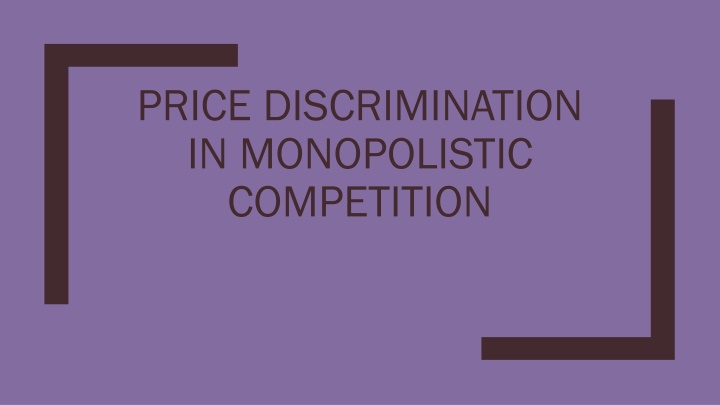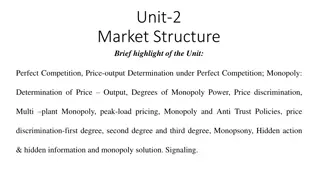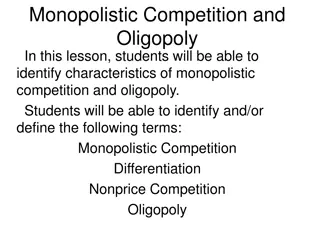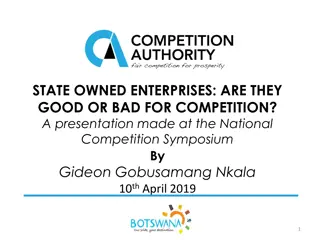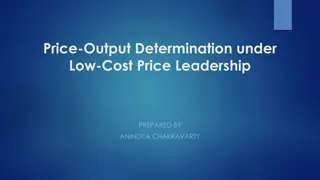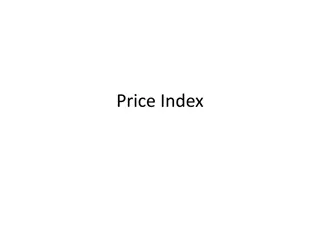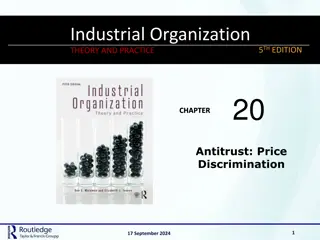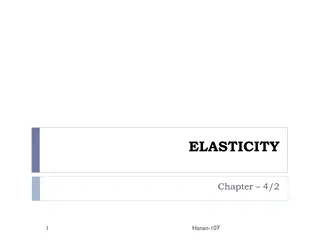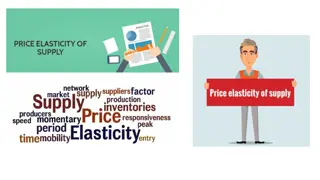Monopolistic Competition and Price Discrimination
Explore the market structures between perfect competition and monopoly, focusing on monopolistic competition. Learn how firms in monopolistic competition set prices and quantities, and examine their ability to earn economic profit. Understand the effects on society's welfare and the implications of advertising in this market structure.
Download Presentation

Please find below an Image/Link to download the presentation.
The content on the website is provided AS IS for your information and personal use only. It may not be sold, licensed, or shared on other websites without obtaining consent from the author.If you encounter any issues during the download, it is possible that the publisher has removed the file from their server.
You are allowed to download the files provided on this website for personal or commercial use, subject to the condition that they are used lawfully. All files are the property of their respective owners.
The content on the website is provided AS IS for your information and personal use only. It may not be sold, licensed, or shared on other websites without obtaining consent from the author.
E N D
Presentation Transcript
PRICE DISCRIMINATION IN MONOPOLISTIC COMPETITION
In this chapter, look for the answers to these questions: What market structures lie between perfect competition and monopoly, and what are their characteristics? How do monopolistically competitive firms choose price and quantity? Do they earn economic profit? In what ways does monopolistic competition affect society s welfare? What are the social costs and benefits of advertising? 2
Introduction: Between Monopoly and Competition Two extremes Perfect competition: many firms, identical products Monopoly: one firm In between these extremes: imperfect competition Oligopoly Oligopoly: only a few sellers offer similar or identical products. Monopolistic competition Monopolistic competition: many firms sell similar but not identical products. 3
Characteristics & Examples of Monopolistic Competition Characteristics: Many sellers Product differentiation Free entry and exit Examples: apartments books bottled water clothing fast food night clubs 4
Comparing Perfect & Monop. Competition Perfect competition Monopolistic competition number of sellers many many free entry/exit yes yes long-run econ. profits zero zero the products firms sell identical differentiated firm has market power? none, price-taker yes downward- sloping D curve facing firm horizontal 5
Comparing Monopoly & Monop. Competition Monopolistic competition Monopoly number of sellers one many free entry/exit no yes long-run econ. profits positive zero firm has market power? yes yes downward- sloping (market demand) downward- sloping D curve facing firm close substitutes none many 6
A Monopolistically Competitive Firm Earning Profits in the Short Run The firm faces a downward-sloping D curve. Price MC profit At each Q Q, MR < P. ATC P To maximize profit, firm produces Q Q where MR = MC. ATC D The firm uses the D curve to set P. MR Q Quantity 7
A Monopolistically Competitive Firm With Losses in the Short Run For this firm, P < ATC at the output where MR = MC. Price MC losses ATC The best this firm can do is to minimize its losses. ATC P D MR Q Quantity 8
Monopolistic Competition and Monopoly Short run: Under monopolistic competition, firm behavior is very similar to monopoly. Long run: In monopolistic competition, entry and exit drive economic profit to zero. If profits in the short run: New firms enter market, taking some demand away from existing firms, prices and profits fall. If losses in the short run: Some firms exit the market, remaining firms enjoy higher demand and prices. 9
A Monopolistic Competitor in the Long Run Entry and exit occurs until P = ATC and profit = zero. Price MC Notice that the firm charges a markup of price over marginal cost and does not produce at minimum ATC. ATC P = ATC markup D MC MR Q Quantity 10
Why Monopolistic Competition Is Less Efficient than Perfect Competition 1. 1. Excess capacity Excess capacity The monopolistic competitor operates on the downward-sloping part of its ATC curve, produces less than the cost-minimizing output. Under perfect competition, firms produce the quantity that minimizes ATC. 2. 2. Markup over marginal cost Markup over marginal cost Under monopolistic competition, P > MC. Under perfect competition, P = MC. MONOPOLIST IC COMPETITIO 11
Monopolistic Competition and Welfare Monopolistically competitive markets do not have all the desirable welfare properties of perfectly competitive markets. Because P > MC, the market quantity is below the socially efficient quantity. Yet, not easy for policymakers to fix this problem: Firms earn zero profits, so cannot require them to reduce prices. 12
Monopolistic Competition and Welfare Number of firms in the market may not be optimal, due to external effects from the entry of new firms: The product The product- -variety externality variety externality: surplus consumers get from the introduction of new products The business The business- -stealing externality stealing externality: losses incurred by existing firms when new firms enter market The inefficiencies of monopolistic competition are subtle and hard to measure. No easy way for policymakers to improve the market outcome. 13
A C T I V E L E A R N I N G 1 Advertising 1. 1. So far, we have studied three market structures: perfect competition, monopoly, and monopolistic competition. In each of these, would you expect to see firms spending money to advertise their products? Why or why not? 2. 2. Is advertising good or bad from society s viewpoint? Try to think of at least one pro and con. 14
Advertising In monopolistically competitive industries, product differentiation and markup pricing lead naturally to the use of advertising. In general, the more differentiated the products, the more advertising firms buy. Economists disagree about the social value of advertising. 15
The Critique of Advertising Critics of advertising believe: Society is wasting the resources it devotes to advertising. Firms advertise to manipulate people s tastes. Advertising impedes competition it creates the perception that products are more differentiated than they really are, allowing higher markups. 16
The Defense of Advertising Defenders of advertising believe: It provides useful information to buyers. Informed buyers can more easily find and exploit price differences. Thus, advertising promotes competition and reduces market power. Results of a prominent study: Eyeglasses were more expensive in states that prohibited advertising by eyeglass makers than in states that did not restrict such advertising. 17
Advertising as a Signal of Quality A firm s willingness to spend huge amounts on advertising may signal the quality of its product to consumers, regardless of the content of ads. Ads may convince buyers to try a product once, but the product must be of high quality for people to become repeat buyers. The most expensive ads are not worthwhile unless they lead to repeat buyers. When consumers see expensive ads, they think the product must be good if the company is willing to spend so much on advertising. 18
Brand Names In many markets, brand name products coexist with generic ones. Firms with brand names usually spend more on advertising, charge higher prices for the products. As with advertising, there is disagreement about the economics of brand names 19
The Critique of Brand Names Critics of brand names believe: Brand names cause consumers to perceive differences that do not really exist. Consumers willingness to pay more for brand names is irrational, fostered by advertising. Eliminating govt protection of trademarks would reduce influence of brand names, result in lower prices. 20
The Defense of Brand Names Defenders of brand names believe: Brand names provide information about quality to consumers. Companies with brand names have incentive to maintain quality, to protect the reputation of their brand names. 21
CONCLUSION Differentiated products are everywhere; examples of monopolistic competition abound. The theory of monopolistic competition describes many markets in the economy, yet offers little guidance to policymakers looking to improve the market s allocation of resources. 22
CHAPTER SUMMARY A monopolistically competitive market has many firms, differentiated products, and free entry. Each firm in a monopolistically competitive market has excess capacity produces less than the quantity that minimizes ATC. Each firm charges a price above marginal cost. 23
CHAPTER SUMMARY Monopolistic competition does not have all of the desirable welfare properties of perfect competition. There is a deadweight loss caused by the markup of price over marginal cost. Also, the number of firms (and thus varieties) can be too large or too small. There is no clear way for policymakers to improve the market outcome. 24
CHAPTER SUMMARY Product differentiation and markup pricing lead to the use of advertising and brand names. Critics of advertising and brand names argue that firms use them to reduce competition and take advantage of consumer irrationality. Defenders argue that firms use them to inform consumers and to compete more vigorously on price and product quality. 25
